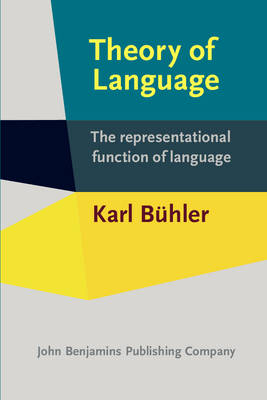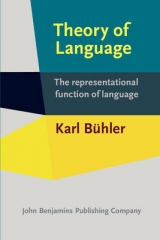Theory of Language
John Benjamins Publishing Co (Verlag)
978-90-272-1182-8 (ISBN)
Karl Bühler (1879–1963) was one of the leading theoreticians of language of the twentieth century. Although primarily a psychologist, Bühler devoted much of his attention to the study of language and language theory. His masterwork Sprachtheorie (1934) quickly gained recognition in the fields of linguistics, semiotics, the philosophy of language and the psychology of language. This new edition of the English translation of Bühler’s theory begins with a survey on ‘Bühler’s legacy’ for modern linguistics (Werner Abraham), followed by the Theory of Language, and finally with a special ‘Postscript: Twenty-five Years Later …’ (Achim Eschbach). Bühler’s theory is divided into four parts. Part I discusses the four axioms or principles of language research, the most famous of which is the first, the organon model, the base of Bühler's instrumental view of language. Part II treats the role of indexicality in language and discusses deixis as one determinant of speech. Part III examines the symbolic field, dealing with context, onomatopoeia and the function of case. Part IV deals with the elements of language and their organization (syllabification, the definition of the word, metaphor, anaphora, etc).The text is accompanied by an Introduction (Achim Eschbach); Translator's preface (Donald Fraser Goodwin); Glossary of terms; and a Bibliography of cited works.
1. Preface (by Abraham, Werner); 2. Editor's Introduction - Karl Buhler: Sematologist (by Eschbach, Achim); 3. Translator's Preface (by Goodwin, Donald Fraser); 4. KARL BUHLER: THEORY OF LANGUAGE: The representational function of language; 5. Preface; 6. Introduction: Theory of Language Yesterday and Today; 7. I. The Principles of Language Research; 8. 1. The Idea and Plan of the Axiomatics; 9. 2. The Model of Language as Organon (A); 10. 3. The Significative Nature of Language (B); 11. 4. Speech Action and Language Work; Speech Act and Language Structure (C); 12. 5. Word and Sentence. The S-F-System of the Type Language (D); 13. II. The Deictic Field of Language and Deictic Words: Introduction; 14. 6. The Psychological Foundations of the Modes of Positional: Deixis in Indo-European; 15. 7. The Origin of the Deictic Field and its Mark; 16. 8. Imagination-Oriented Deixis and the Anaphoric Use of Deictic Words; 17. 9. Egocentric and Topomnestic Deixis in Various Languages; 18. III. The Symbolic Field of Language and the Naming Words: The programme; 19. 10. The Sympractical, the SYDlphysical and the Synsemantic Field of Language Signs; 20. 11. Context and Field Factors in Detail; 21. 12. Symbolic Fields in Non-Linguistic Representative Implements; 22. 13. Onomatopoetic Language; 23. 14. The Conceptual Signs of Language; 24. 15. The Indo-European Case System as an Example of a Field Implement; 25. 16. A Critical Review; 26. IV. The Make-up of Human Speech: Elements and Compositions: Introduction; 27. 17. The Materially Determined Formation of the Acoustic Stream of Speech; 28. 18. The Sound Shape and the Itemized Phonematic Description of Words; 29. 19. The Simple and the Complex Word. The Characteristics of the Concept of the Word; 30. 20. The Functions of the Article; 31. 21. The Summative And; 32. 22. Language Theoretical Studies on the Compound; 33. 23. The Metaphor in Language; 34. 24. The Problem of the Sentence; 35. 25. The Sentence without a Deictic Field; 36. 26. The Anaphora; 37. 27. The Formal World of the Compound Sentence (a Sketch); 38. Bibliography; 39. Glossary; 40. Index of names; 41. Index of topics; 42. Postscript
| Mitarbeit |
Assistent: Achim Eschbach |
|---|---|
| Übersetzer | Donald Fraser Goodwin |
| Verlagsort | Amsterdam |
| Sprache | englisch |
| Maße | 160 x 240 mm |
| Gewicht | 1070 g |
| Themenwelt | Geisteswissenschaften ► Philosophie ► Sprachphilosophie |
| ISBN-10 | 90-272-1182-5 / 9027211825 |
| ISBN-13 | 978-90-272-1182-8 / 9789027211828 |
| Zustand | Neuware |
| Haben Sie eine Frage zum Produkt? |
aus dem Bereich




